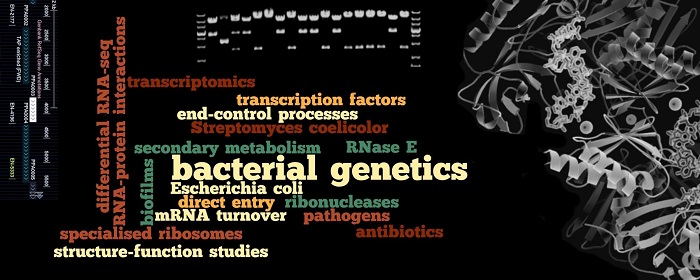Professor Kenneth McDowall
- Position
- Professor of Molecular Microbiology
- Areas of expertise
- Post-transcriptional gene regulation; bacterial natural products; microbiomes; and metagenomics
- Location
- Garstang 8.52d
- Faculty
- Biological Sciences
- School
- Molecular and Cellular Biology
Introduction
Our research focuses on understanding processes that determine the fundamental characteristics of bacteria, which are the source of clinically important drugs, metabolites that affect our physiology and even psychology, and powerful molecular tools most recently CRISPR/Cas9. We utilise tools ranging from structural molecular biology to high-throughput, meta’omics approaches as part of multidisciplinary teams that include clinicians and physiologists. We have roots in studying the mechanistic basis of RNA degradation of bacteria, which is central to the control of gene regulation and in turn the composite observable characteristics that determine their ecological position and relationship with humankind. The cryptic nature of much of the secondary metabolism of Streptomyces, which is a major source of antibiotics and anticancer agents is also of long-term interest. Through collaborations, we are also utilising our expertise to develop tools for the non-invasive detection of sources of bacterial infection, investigate the relationship between the gut microbiota and health, and develop approaches to facilitate the effective re-mining of the soil microbiota for new sources of antibiotics.
Current major projects
- Activation of the major component of the RNA degradosome of Escherichia coli
- Identifying mechanisms that determine the cryptic nature of secondary metabolism in Streptomyces
- The meta’omics analysis of complex microbial communities of physiological and pharmaceutical importance
Detailed research programme
A role for a newly discovered RNA-binding groove in the activation of mRNA turnover?
RNase E, an endoribonuclease found in many bacteria, undertakes essential roles in the processing and degradation of RNA. Previous work by us on RNase E from Escherichia coli, has suggested that tRNA processing requires RNase E to interact with structured as well as single-stranded regions via a site that had not yet been identified. Recently, X-ray crystallography by collaborators revealed an interaction between a groove, distal to the site of catalysis, and a duplex region of a small regulatory RNA. We are exploring the role of this RNA-binding groove using a combination of genetics, molecular and structural biology, and have recently found it contacts tRNA, is essential for efficient cleavage of tRNA precursors and likely mediates allosteric regulation. The structural basis of these observations is being explored using EM as well as new sequencing approaches to facilitate transcriptome-wide analyses.
Reversing the cryptic nature of secondary metabolism
The current need for new antibiotics clinically is well documented. A variety of approaches are being taken to meet this need including the renewed mining of Streptomyces natural products using methodologies that provide greater depth and target antibiotic-resistant pathogens. One key objective is to reverse under laboratory conditions the cryptic nature of much of the secondary metabolism of Streptomyces, which is known to be regulated by numerous transduction systems. However, for many, if not most, the actual regulatory signal has yet to be identified. The greatest benefit is likely to be derived from the manipulation of transduction systems that are evolutionarily conserved and have regulons covering multiple Streptomyces natural products. We are characterising an evolutionarily conserved one-component, signal transducer that has been shown by us and others to the production of secondary metabolites in several Streptomyces species. Unexpectedly, our studies have revealed that Streptomyces may produce non-specific inhibitors of DNA: protein interactions. It is speculated that such inhibitions may provide an undescribed mechanism for quelling housekeeping transcription as part of the Streptomyces life cycle.
Harnessing the power of meta-genomics
The latest high-throughput sequencing techniques are being utilised to study communities and other complex assemblies of bacteria. We are for example using a meta-genomics approach to identify the ability of low molecular weight substances extracted from soil using a range of organic solvents to facilitate the growth of previously unculturable soil bacteria that may produce previously unidentified natural products with novel antibacterial activity. We are also using meta-genomics to characterise the microbiota of pigs and cows that differ in health and performance. Recently, bacterial genera have been identified that are associated with improved digestion of grasses by ruminal fluids. Engineering of the microbiota may reduce the environmental pressures of ruminant production by improving digestive efficiency.

